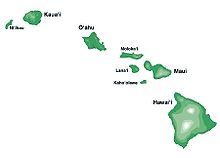Agriculture is an important part of the economy of Hawaii. Though Hawaii relies heavily on imports of food from mainland United States and other parts of the world, export of cash crop specific to the tropical growing environment of Hawaii has made agriculture one of the more important economic sectors.
During the early part of control of Hawaii by the United States, early cash crops included pineapple and sugar, which were tightly controlled by a small network of businessmen " the Big Five", who monopolized control of the sugar industry's profits. [1] The industry has since diversified in terms of ownership in exports.
According to the USDA in 2022, the state of Hawaii had over 7300 farm operations working on 1,100,000 acres. [2] By weight, honey bees may be the state's most valuable export. [3] According to the Hawaii Agricultural Statistics Service, agricultural sales were US$370.9 million from diversified agriculture, US$100.6 million from pineapple, and US$64.3 million from sugarcane. Hawaii's relatively consistent climate has attracted the seed industry, which is able to test three generations of crops per year on the islands, compared with one or two on the mainland. [4] Seeds yielded US$264 million in 2012, supporting 1,400 workers. [5]
Historic practices
Aquaculture

Before contact with Europeans, the Hawaiian people practiced aquaculture through development of fish ponds ( Hawaiian: loko iʻa), the most advanced fish-husbandry among the original peoples of the Pacific. While other cultures in places like Egypt and China also used the practice, Hawaii's aquaculture was very advanced considering the much smaller size of the area of Hawaii compared to other aquacultural societies. [6] Hawaiian fishponds were typically shallow areas of a reef flat surrounded by a low lava rock wall (loko kuapa) built out from the shore. Several species of edible fish (such as mullet) thrive in such ponds, and Hawaiians developed methods to make them easy to catch.
"The full-scale development of loko i‘a (fishponds) from mauka (the mountains) to makai (the ocean) dates back over half a millennium. Cultivation and propagation centered on many different fresh and salt-water plants and animals, with the primary species being the prized ‘ama‘ama ( mullet) and ‘awa ( milkfish). An inventory in the early 1900s found 360 loko i‘a in the islands and identified 99 active ponds with an estimated annual production total of about 680,000 pounds, including 486,000 pounds of ‘ama‘ama and 194,000 pounds of ‘awa. Loko i‘a were extensive operating systems that produced an average of 400–600 pounds per acre per year, a significant amount considering the minimal amount of fishpond 'input' and maintenance effort apparent by that time."
"A Manual on Hawaiian Fishpond Restoration and Management" CTAHR University of Hawai'i [7]
Crops
Coffee
Hawaii is one of the few U.S. states where coffee production is a significant economic industry – coffee is the second largest crop produced there. The 2019–2020 coffee harvest in Hawaii was valued at $102.9 million. [8] As of the 2019-2020 harvest, coffee production in Hawaii accounted for 6,900 acres of land [9]
The coffee industry in Hawaii is well supported by organizations such as the Hawaii Coffee Association, the Hawaii Agriculture Resource Center and the College of Tropical Agriculture and Human Resources, University of Hawaii at Manoa and the state's Department of Agriculture.Macadamia nuts


Sugar

Wine

Issues
GMOs
Genetic engineering in Hawaii is a hotly contested political topic. The Hawaiian islands counties of Kauai, Hawaii and Maui passed or considered laws restricting the practice within their borders due to concerns about the health, the environment and impacts on conventional and organic agriculture. [15]
Hawaii is attractive to researchers and seed companies because of its moderate year-round climate—an average of 75 °F (24 °C), which allows 3 or more harvests per year, greatly reducing the length of time required to develop a new seed. [15]
The main companies working with genetically modified crops in Hawaii are Monsanto, Syngenta, Pioneer Hi-Bred, BASF, Mycogen Seeds and Agrigentics.[ citation needed]
Gene manipulation is generally conducted elsewhere. Hawaii sites cross the engineered strains with other strains to eliminate undesirable traits and cultivate the hybrids to produce seeds that are then planted elsewhere.References
- ^ MacLennan, Carol (2004). "The Mark of Sugar. Hawai'i's Eco-Industrial Heritage". Historical Social Research / Historische Sozialforschung. 29 (3 (109)): 37–62. ISSN 0172-6404. JSTOR 20761975.
- ^ "USDA/NASS 2022 State Agriculture Overview for Hawaii". www.nass.usda.gov. Retrieved March 11, 2023.
- ^ "Hawaii honeybees vie for most valuable export". Archived from the original on March 14, 2018. Retrieved December 15, 2011.
- ^ "Hawaii is genetically engineered crop flash point". KLEW_TV. Associated Press. April 19, 2014. Archived from the original on November 12, 2019. Retrieved April 18, 2018.
- ^ Pollack, Andrew (October 7, 2013). "Unease in Hawaii's Cornfields". The New York Times. Archived from the original on August 31, 2014. Retrieved October 18, 2014.
- ^ Penn, David C. (1993). "Water Needs for Sustainable Taro Culture in Hawai'i". Research Extension Series. 140: 132–134. hdl: 10125/4294. ISSN 0271-9916.
- ^ "LOKO I'A "A Manual on Hawaiian Fishpond Restoration and Management"" (PDF). College of Tropical Agriculture and Human Resources. University of Hawaii. Retrieved December 22, 2020.
- ^ "Hawaii Coffee Association - Coffee Industry Valued Higher Now". hawaiicoffeeassoc.org. Retrieved April 18, 2021.
- ^ Coffee Acreage, Yield, Production, Price and Value State of Hawaii, 2020 (PDF). Hawaii. May 2020.
- ^ "Hawaiian Host Finalizes Purchase Of Mauna Loa Macadamia Nut". company web site. Retrieved June 3, 2016.
- ^ Deerr, 1949
- ^ Urcia, 1960
- ^ Lyte, Brittany (December 17, 2017). "With pineapple and sugar production gone, Hawaii weighs its agricultural future". Washington Post. ISSN 0190-8286. Retrieved May 9, 2018.
- ^ Robinson, Jancis, ed. (2006). The Oxford Companion to Wine (3 ed.). Oxford University Press. p. 341. ISBN 978-0-19-860990-2.
- ^ a b Boyd, Robynne (December 8, 2008). "Genetically Modified Hawaii New varieties of genetically engineered crops thrive in the world's most isolated landmass". Scientific American. Retrieved October 15, 2014.
